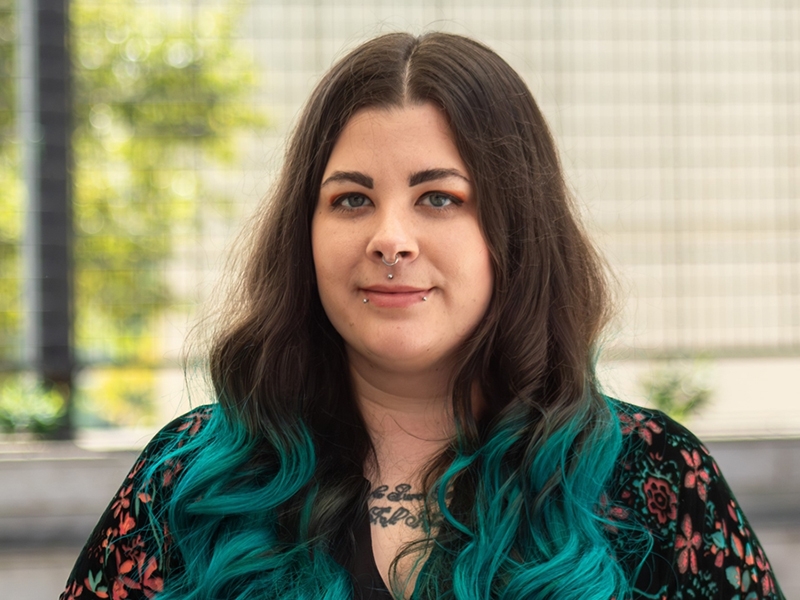
Kasandra Wright, U of A apparel merchandising and product development major, has been named the national winner of the inaugural NEXTILE: The Soy in Textiles Design Challenge.
The challenge asked students across the country to leverage creative and problem-solving skills to produce the next sustainable innovation in textile design, but they were required to create their products using one versatile ingredient — soybeans.
Each individual or team received a design kit including seven sustainable, soy-based materials: soy thread, soy leather, soy French Terry, organic pigment and other soy products. Project submissions leveraged one or more of these ingredients to produce new textile threads, dyes, paints, designs and more.
Wright was named the university-level winner in February to advance to the national finals.
Her design, a moth skirt, included sustainable elements soy French Terry, soy top roving, soy silk thread and bio tex modern meadows soy leather natural pigment with soymilk soak.
The competition, sponsored by the United Soybean Board, aimed to support professors teaching sustainability and textile designs. It provided college students with an opportunity to showcase creative and problem-solving skills, leading to contributions to increased sustainability of textiles for various applications.
Wright incorporated the Batik textile technique involving the application of wax and dye to fabric in order to craft intricate patterns.
"Throughout this experience, I learned about the importance of what soy-based products can provide in the apparel and textile industry," Wright said. "Soy fiber has an excellent drape and is a beautiful alternative to protein fibers as a sustainable material for apparel."
As the winner, Wright receives a $1,000 scholarship.
Wright is mentored by Lance Cheramie, teaching assistant professor of AMPD in the Dale Bumpers College of Agricultural, Food and Life Sciences' School of Human Environmental Sciences.
"I am profoundly honored to have mentored Kasandra, who emerged as the national winner of the NEXTILE soy-based textile competition," Cheramie said. "Witnessing her steadfast dedication, limitless creativity and authentic passion for her craft has been truly awe-inspiring. Kasandra's contributions not only exhibited her outstanding talent, but also emphasized her skill set as a student within the AMPD program. It's abundantly clear that her potential is limitless, and I have full confidence that she will achieve extraordinary success in her career endeavors."
"The use of soy as the main ingredient in textiles not only reduces our dependence on non-renewable resources, such as petroleum-based textiles, and the reliance on animal-based textiles, but also helps minimize carbon emissions and promotes a circular economy," Wright said after being named the university-level winner.
Anna Stuffelbeam from North Carolina State University finished second.
Wright was named the winner from a pool of students who advanced past the first round of judging, including students from six schools across the country. Judges from Levander Design, Springs Creative Products Group, United Soybean Board and Modern Meadow chose the winner and runner-up.
"It's been incredible to see how our soybeans come to life in the creative hands of these talented students, especially Kasandra and Anna," said Carla Schultz, Michigan soybean farmer and United Soybean Board director who served as a judge of the competition. "I'm so impressed with their designs — they were artful, progressive and captivating. I'm beyond excited by the creative thinking we saw in the inaugural NEXTILE Challenge. I'm excited for the future of each competitor who participated and for the future of soy."
NEXTILE was created to put sustainable soy materials into the hands of young designers to create eco-friendly textile solutions.
Soy has long been a key ingredient for product innovation, going back to Henry Ford, who used soy-based paints, textile materials and plastics for automobile design. U.S. Soy is in more than 1,000 products on the market — from tires and shoes to fabrics and artificial grass. Soy is a renewable crop, replenishing soil annually with each growing season, and is important for biobased products.
About the Dale Bumpers College of Agricultural, Food and Life Sciences: Bumpers College provides life-changing opportunities to position and prepare graduates who will be leaders in the businesses associated with foods, family, the environment, agriculture, sustainability and human quality of life; and who will be first-choice candidates of employers looking for leaders, innovators, policy makers and entrepreneurs. The college is named for Dale Bumpers, former Arkansas governor and longtime U.S. senator who made the state prominent in national and international agriculture. For more information about Bumpers College, visit our website, and follow us on Twitter at @BumpersCollege and Instagram at BumpersCollege.
About the University of Arkansas: As Arkansas' flagship institution, the U of A provides an internationally competitive education in more than 200 academic programs. Founded in 1871, the U of A contributes more than $2.2 billion to Arkansas' economy through the teaching of new knowledge and skills, entrepreneurship and job development, discovery through research and creative activity while also providing training for professional disciplines. The Carnegie Foundation classifies the U of A among the few U.S. colleges and universities with the highest level of research activity. U.S. News & World Report ranks the U of A among the top public universities in the nation. See how the U of A works to build a better world at Arkansas Research and Economic Development News.
Topics
Contacts
Robby Edwards, director of communications
Dale Bumpers College of Agricultural, Food and Life Sciences
479-575-4625, robbye@uark.edu